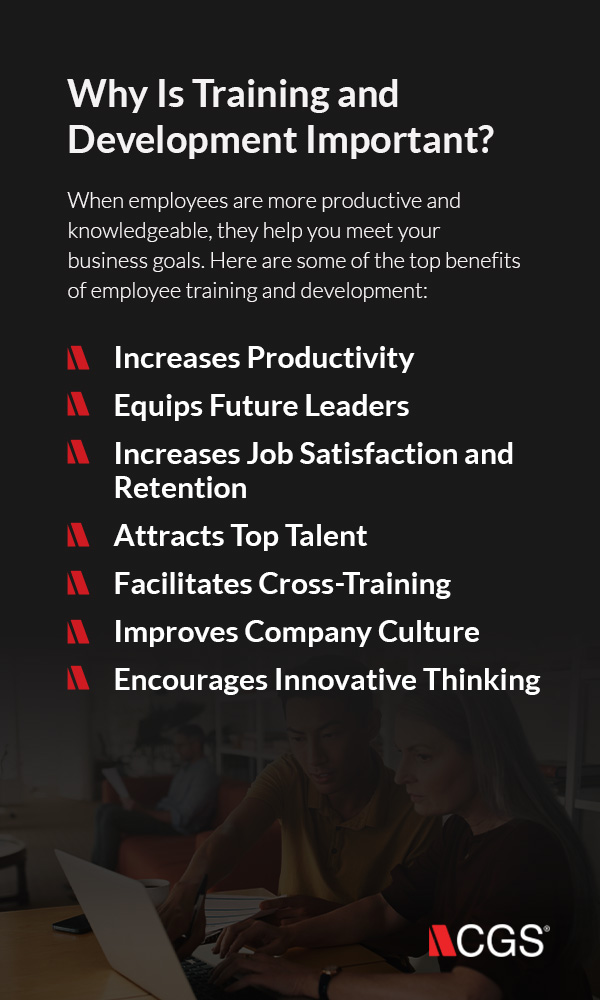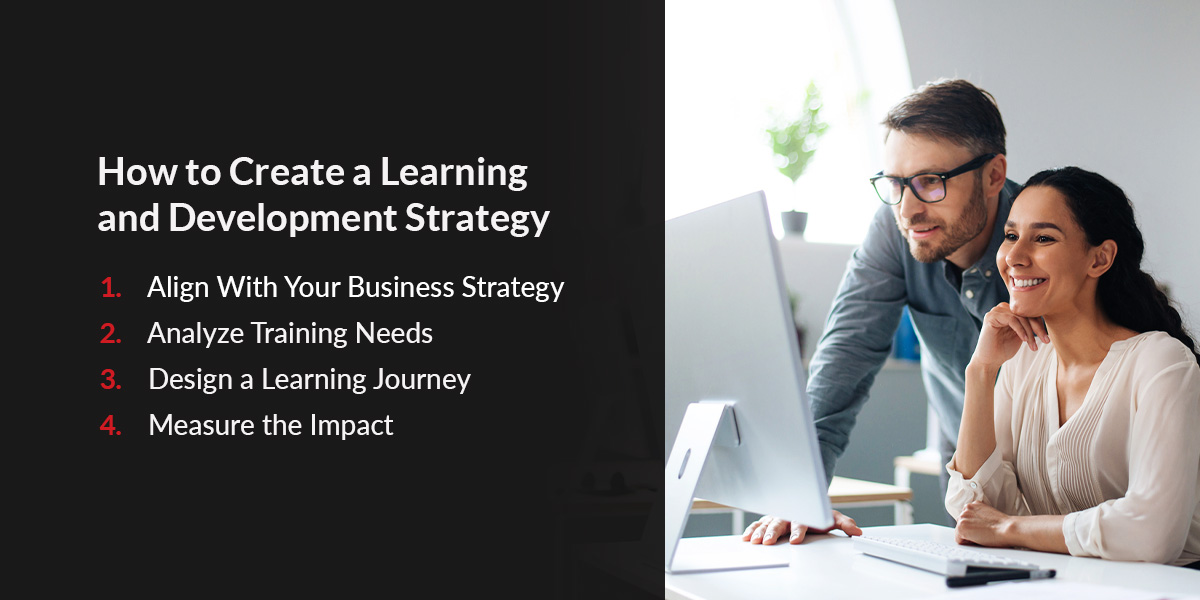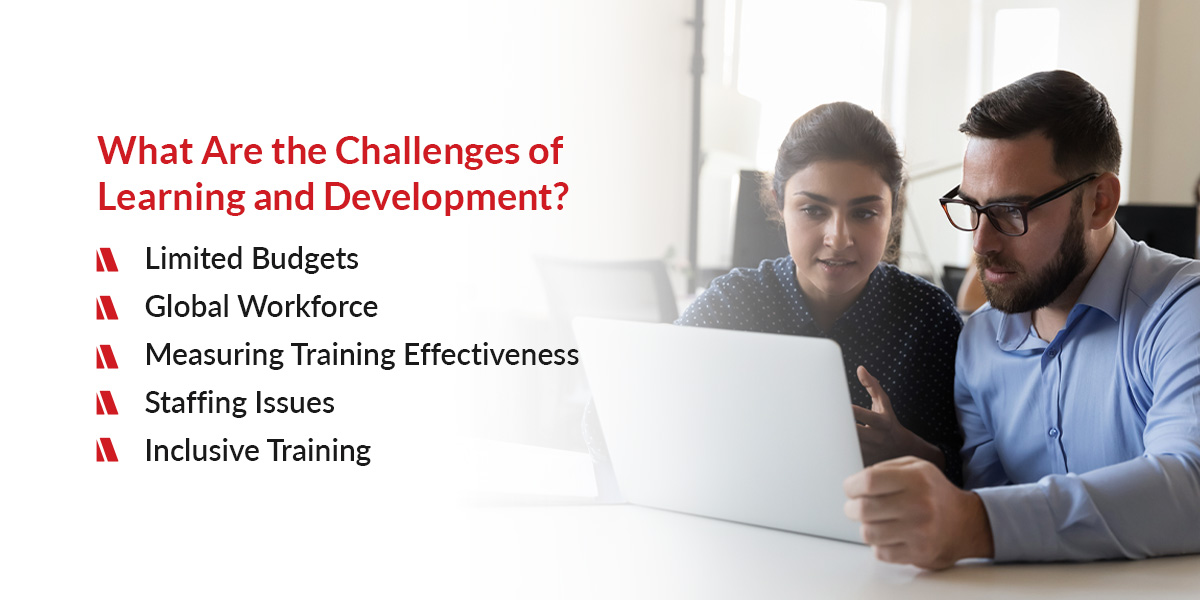Topics
Learning and Development: What It Is and Why It’s Important

Employee training and development are how businesses upskill and expand their workforce's knowledge and capabilities. Careful planning and strategizing lay the foundation for successful learning and development training. Your efforts should add value to your employees while prioritizing your business goals.
There is a range of learning styles and methods to consider that can enhance your employee's engagement with learning and development initiatives. When your company creates impactful learning and development solutions, your team can reap the full benefits of a productive workforce that works together to achieve your business's goals.
What Is Learning and Development?
So, what is L&D? Learning and development training, or L&D training, is a series of initiatives a company carries out to improve job performance. These learning initiatives are educational activities that advance knowledge and skills. Some training methods include lectures, workshops, digital learning, immersive learning, job aids and simulations.
People often interchange learning and development, but the two slightly differ. Learning focuses on equipping employees with new knowledge, skills and outlooks. Development training for employees deepens and expands their knowledge. It aligns with employee development goals and a business's long-term goals. In many cases, development is voluntary, whereas learning is mandatory.
What Is Enterprise Learning?
Enterprise learning is a system and strategy that ensures employees can access knowledge and learning when needed. Instead of telling employees when and how to learn, enterprise learning enables them to access educational material at the time of need. They can channel their curiosity and expand their knowledge at their own pace.
An enterprise learning strategy begins with the company's goals and breaks down into various departments and employee groups. A successful system also expands outside the company's walls and informs employees about the services, products and industry.

Why Is Training and Development Important?
Learning and development training enables companies to upskill employees, improving productivity and creating a positive culture. When employees are more productive and knowledgeable, they help you meet your business goals. Here are some of the top benefits of employee training and development:
Increases Productivity
L&D training empowers staff to work more efficiently. These training programs help employees manage tasks better. They can complete assignments in less time when they have a greater understanding of processes.
Equipped employees are confident employees. When employees are secure in their ability to perform their work, it fosters enthusiasm and greater accountability to deliver results. Staff can work independently with less micromanaging and oversight.
Equips Future Leaders
When you have a pipeline of future leaders, you can promote them from within your company. Having strong talent that can fill future roles saves your business from spending on recruiting, hiring, training and on onboarding new employees. Your current staff knows your company's goals and operations, making them the perfect candidates for future leadership positions.
Increases Job Satisfaction and Retention
Employees who see a future within a company and know the company invests in them are often more likely to stay. Employee turnover costs U.S. businesses $1 trillion every year. These costs are an incentive to upskill your workforce. Lack of training and development are among the main reasons people leave their jobs. Training motivates staff, improves job satisfaction and creates opportunities for advancement in your business.
Attracts Top Talent
Highly skilled employees can be more attracted to companies that offer clear career progression. Learning and development for employees are often among the top benefits that people want from an employer. When you hire employees, engage with them about their goals and give them access to training to help them achieve them.
Facilitates Cross-Training
Cross-training also enables staff to learn about the different roles within their team and how their work impacts their colleague's tasks and vice versa. It can also equip team members to cover for one another when someone is sick or out of the office.
Cross-training goes beyond temporary roles. When an employee is taking on new responsibilities, training and development can help them prepare. You can introduce new skills to them they didn't have before for success in their new or future role.
Improves Company Culture
Mastering a new skill creates a sense of accomplishment. Recognizing employees for their training and development milestones can increase their happiness in their role and boosts their morale.
Job satisfaction helps build a positive company reputation, as employees will relate to and talk about your company positively. They are also more likely to perform their jobs well, so this positive reputation will also extend to customers and other stakeholders.
Encourages Innovative Thinking
Employee training and development exposes your workforce to new ways of doing things, which they can adapt to their jobs. As new technologies and systems enter the market, employees can stay updated on industry trends. This learning encourages staff to think innovatively and find new ways to improve processes.
This exposure can also lead staff to discover strengths and talents they didn't know they had. They can then apply these newfound strengths to their roles by taking on new positions or duties that help your business to reach its goals. Studies show that teams have the best outcomes when 90% or more employees know their strengths.
What Are Learning and Development Examples?
Your company's methods to train employees are just as important as the material you teach. Workforces are diverse, and each employee has a preferred learning style. These styles fall into three main categories:
- Visual learning: Seeing or watching material
- Auditory learning: Listening to information
- Kinesthetic learning: Education by doing
The best training programs aim to target all three learning styles by incorporating various learning methods. Collecting data on your learning programs lets you learn what form works best for your employees.
Online or Computer-Based Training
As the name suggests, this training either takes place via an online portal or computer files. The great thing about this training is that staff can work through it at their own time and pace. Online training also enables remote workers to access training from anywhere. This training can easily mimic an instructor-led setting with a voiceover and supporting resources such as visuals, video and supplementary reading.
This training also enables scalability. No matter how big your workforce is, all employees can access the material simultaneously and advance at their own pace. The one downside to this method is the need for more visibility regarding employee progress. Including quizzes and interactive modules can give you an idea of whether they are paying attention.
Mentorship
A mentorship program is beneficial, especially for new employees. They can learn from a senior team member, and it helps them feel supported and welcomed. A mentor will have to take time away from their job to train a new employee, but the benefits from this one-on-one training are worth it in the long run.
Classroom-Style Learning
In this method, an instructor leads the training in a classroom style, usually featuring a visual component like a slideshow. This in-person training empowers employees to ask questions that may go unanswered in other settings. Colleagues can also interact and learn from each other.
Scalability is a challenge in this method. Classrooms have limited capacity, and the bigger the class gets, the less one-on-one interaction an instructor can have with students. This style also makes it difficult for staff to learn at their own pace.
To make the most out of this learning style, allow trainees breaks in between and include interactive activities to maintain their interest.
On-The-Job Training
This method gives employees hands-on training as they dive straight into their work from day one. It's wise to include a job shadowing component, where a trainee can learn from a senior team member and understand the job requirements before they begin to carry out responsibilities independently.
Simulation Training
This training is particularly effective in fields where employees need specific skills to operate heavy machinery. Simulators are used in aviation to prepare trainees by mimicking real-life situations they will face on the job. This learning option helps develop problem-solving skills so staff can confidently tackle these situations.
Case Studies
Case studies are an excellent method if you want to develop problem-solving and analytical thinking in your team. Trainees work independently or in groups to find solutions for real-life or imaginary situations. This type of training is also a great way to foster collaboration within teams.
How to Create a Learning and Development Strategy
There are a few steps to work through to lay the foundation of a robust learning and development strategy. Continue reviewing your learning and development strategy to ensure it meets your goals and helps you fill any skills gaps in your business.

1. Align With Your Business Strategy
Learning and development should align with your business strategy, goals and priorities. Your L&D training can help you implement your business strategy.
For example, if one of your goals is systems efficiency, then learning and development must equip employees with the necessary skills to make this happen. L&D efforts shouldn't be just for the sake of learning. Reevaluate the alignment between your business strategy and L&D yearly to ensure the training agenda is relevant and aligned with your organization's objectives.
2. Analyze Training Needs
Businesses need to analyze their workforce and understand how to upskill employees to fulfill business strategies and goals. How does each function contribute to the overall business goals, and what skills will ensure success? You should identify what talents, attitudes and knowledge are crucial for employees to perform their roles successfully.
An employee annual performance review can help you analyze the individual performance of each employee. You can learn more about an employee's goals, understand how they perform their role and what upskilling they need. After assessing each function and position, you should also ask your employees to rate these areas and see whether there are any gaps that they identify.
Seeing the gap between the business strategy and training needs is a great way to motivate for L&D training within your company.
3. Design a Learning Journey
Creating clear learning objectives is the foundation of your training methods and materials. Your training objectives should be particular and measurable to improve skills effectively. Once you have identified your L&D objectives, you can design your training programs.
Traditional L&D methods consist of classroom training, but companies are moving away from this by creating learning journeys. This continuous learning style takes place over time, and employees can move at their own pace. A learning journey incorporates L&D methods such as workshops, fieldwork, online learning, mentorship and on-the-job training. Instead of spending hours in a classroom setting, a learning journey aims to help your employees develop the skills they need most efficiently and effectively.
It's best to first execute your program to a small target audience to test your L&D initiative. Once you've successfully implemented it with this group, you can roll it out to the rest of your organization.
4. Measure the Impact
Use key performance indicators (KPIs) to measure the success and effectiveness of your L&D strategy. Base your KPIs on how the strategy aligns with business goals, whether the learning changes employee behavior and performance and how well your workforce uses learning investments and resources.
Measuring impact can be complex. Many organizations still rely on metrics such as completion rate and employee satisfaction with learning initiatives. These metrics give little insight. Outcomes-based metrics like employee engagement, individual performance and improvement in business processes tell the true story of the effectiveness.

What Are the Challenges of Learning and Development?
Organizations may encounter some roadblocks when implementing L&D initiatives. Every workforce and industry is unique. However, L&D functions will likely face one or more of these challenges.
Limited Budgets
Delivering impactful learning and development programs on a tight budget is a challenge for some organizations. As leadership shifts budgets to prioritize areas such as salary increases or digital transformation, L&D leaders must find innovative ways to do more training with a small budget.
To overcome this challenge, you can give employees access to third-party learning solutions to work through independently. Mentorship programs and knowledge sharing on an organization platform are both cost-effective methods to help employees learn and access knowledge.
Global Workforce
Hybrid and remote working models present growth opportunities but also come with challenges. If your organization has employees in other countries, you may experience time zone issues, company culture differences and language barriers. When companies go global, their L&D programs may also have to comply with international regulations and unfamiliar business processes.
When your business does expand, the first step is to identify these challenges. Next, analyze your training programs and understand where you can tweak the initiatives for a global workforce and where you need new training initiatives. Technology and online learning are helpful tools in giving your international employees access to learning and development materials.
Measuring Training Effectiveness
Demonstrating the effectiveness of a program and measuring employee engagement is challenging. It's essential that businesses find a way to ensure employees are actively participating in programs and that they apply the skills they learn in the work environment.
Businesses should include a mix of different learning styles to enhance the effectiveness of programs and boost engagement. Personalize training with mentorship or on-the-job training options. Employees also need clear learning objectives to know what you expect once they complete the training.
Staffing Issues
Staffing challenges have led to learning and development problems in companies. Smaller teams have less time to train employees, and new employees need fast onboarding. Companies need to find innovative ways to overcome these challenges or staffing issues will continue.
Technology and online learning are solutions companies use to overcome this challenge. Instead of training staff in person, shift to learning and development on digital platforms to make training more efficient. To help onboard new employees as quickly as possible, have a well-documented onboarding process that encourages them to complete parts of the training independently.
Inclusive Training
A diverse workforce will consist of employees from various backgrounds who take unique approaches to learning. When creating L&D programs, consider your workforce's needs, language barriers, learning styles, experiences and preferences.
Avoid cultural insensitivity or bias when developing training material. Remove any material that has the potential to be offensive or confusing to demographics so all employees can benefit from and enjoy the training. When training is in-person, encourage healthy debates where employees can be open and respectfully disagree.

Connect With a Learning Specialist at CGS
Learning and development help retain employees and foster a productive, motivated workforce. At CGS, we understand the benefits and challenges that organizations face in L&D initiatives. Through custom learning and development solutions, ranging from game-based training to globally delivered instructor-led training, we help businesses build strong workforces.
We pair learning and development best practices with tech-forward training to give your employees access to training on any device, no matter where they are in the world. Our goal is to make everyone a genius. To learn more about our L&D tools, contact a learning specialist!
Sources:
- https://www.cgsinc.com/en/learning
- https://www.gallup.com/workplace/247391/fixable-problem-costs-businesses-trillion.aspx
- https://www.gallup.com/workplace/470621/why-build-strengths-based-culture.aspx
- https://money.usnews.com/careers/articles/what-is-job-shadowing
- https://hbr.org/2022/07/how-to-conduct-a-great-performance-review
- https://www.cgsinc.com/en/contact

